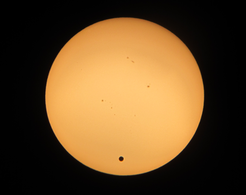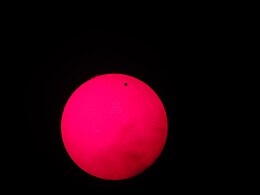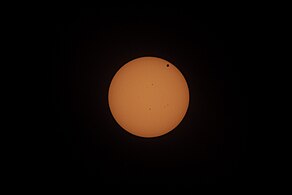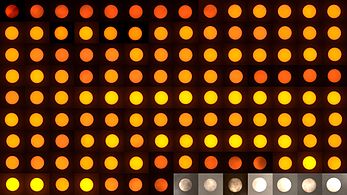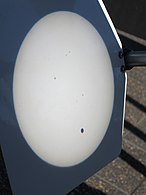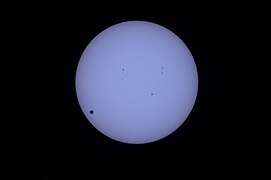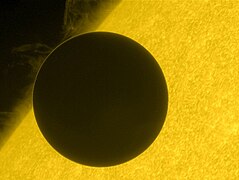2012 transit of Venus
(Redirected from
Transit of Venus, 2012
)

The 2012 transit of Venus, when the planet
22nd century.[3]
Observations of the event


The entire transit was visible from the western
western Africa
. There were a number of live online video streams with footage from telescopes around the world. Midway through the transit one of the NASA streams had nearly 2 million total views and was getting roughly 90,000 viewers at any given moment.
In
Don Pettit aboard the International Space Station.[6]
NASA's
temporal cadence of one every 10 seconds. This is something we've never had before".[7]
Research

The 2012 transit gave scientists a number of research opportunities. These included:[8][9][10]
- Measurement of dips in a star's brightness caused by a known planet transiting a known star (the Sun). This will help astronomers when searching for exoplanets. Unlike the 2004 Venus transit, the 2012 transit occurred during an active phase of the 11-year activity cycle of the Sun, and would have provided practice in detecting a planet's signal around a "spotty" variable star.
- Measurement of the apparent diameter of Venus during the transit, and comparison with its known diameter. This will have given information on how to estimate exoplanet sizes.
- The number of locations documenting the event will provide much data via parallax that will generate more accurate measurements.
- Observation of the atmosphere of Venus simultaneously from Earth-based telescopes and from the Venus Express spacecraft. This gave a better opportunity to understand the intermediate level of Venus's atmosphere than is possible from either viewpoint alone, and should provide new information about the climate of the planet.
- Spectrographic study of the atmosphere of Venus. The results of analysis of the well-understood atmosphere of Venus will be compared with studies of exoplanets with atmospheres that are unknown.
- The Hubble Space Telescope used the Moon as a mirror to study the light reflected from Venus to determine the makeup of its atmosphere. This may provide another technique to study exoplanets.
- Experimental reconstruction of Lomonosov's discovery of Venusian atmosphere (1761) with antique refractors.[11] The researchers observed the "Lomonosov's arc" and other aureole effects due to Venus's atmosphere and concluded that Lomonosov's telescope was fully adequate to the task of detecting the arc of light around Venus off the Sun's disc during ingress or egress if proper experimental techniques as described by Lomonosov in his 1761 paper are employed.[11]
Gallery
North America:
-
San Francisco, California, United States
Transit of airliner with Venus -
Tempe, Arizona, USA
01:54 UTC -
Wichita Falls, Texas, USA
-
Fennell Observatory
Oakland, Tennessee, USA -
Toronto, Ontario, Canada
23:06 UTC
Europe:
-
Ragusa, Sicily, Italy
04:11 UTC -
Moscow, Russia
03:47 UTC -
Helsingborg, Sweden
04:20 UTC -
Kecskemét, Hungary
03:41 UTC
Asia:
-
Kuwait City, Kuwait
-
Delhi, India
-
Guangzhou, China
00:41 UTC -
Video from Ussuriysk, Russia
00:08–04:43 UTC -
Video from Handa, Aichi, Japan
23:36–04:50 UTC
Australasia:
-
Sydney
23:25 UTC -
Wagga Wagga
00:49 UTC -
Clayton
01:06 UTC
Others:
-
Solar Dynamics Observatory Ultra-high Definition View
-
This visualization shows the orbital paths of Venus and Earth that led to this rare alignment on 5–6 June 2012
-
Venus transit, seen from the International Space Station.
-
Close-up of Venus by the Japanese Hinode spacecraft on the Sun-synchronous orbit.
-
Visualization generated by compositing the small field-of-view, high-cadence closeups of Venus with the full-disk, low-cadence imagery from SDO.
References
- ^ Espenak, Fred. "2012 Transit of Venus". NASA. Retrieved 6 June 2012.
- ^ Withrow, Jay (2 June 2012). "Venus-sun event rarer than Halley's Comet". Omaha World-Herald. Archived from the original on 7 September 2012. Retrieved 6 June 2012.
- ^ Klotz, Irene (6 June 2012). "Venus transit offers opportunity to study planet's atmosphere (+video)". Christian Science Monitor. Retrieved 6 June 2012.
- ISSN 0951-9726.
- ^ "Last transit of Venus this century draws stargazers around the world". The Guardian. 6 June 2012. Retrieved 6 June 2012.
- ^ "Stargazers watch rare Venus transit". Al Jazeera. 6 June 2012. Retrieved 6 June 2012.
- ^ Amos, Jonathan (6 June 2012). "Venus makes rare trek across Sun". BBC News. Retrieved 6 June 2012.
- ^ Wall, Mike (16 May 2012). "Venus Transit On June 5 May Bring New Alien Planet Discoveries". The Huffington Post. Retrieved 6 June 2012.
- ^ "Counting down to the Transit of Venus – our nearest exoplanet test-lab". Phys.Org. 5 March 2012. Retrieved 6 June 2012.
- ^ "The Venus Twilight Experiment: Refraction and scattering phenomena during the transit of Venus on June 5–6, 2012". venustex.oca.eu. Archived from the original on 23 October 2016. Retrieved 6 June 2012.
- ^ .
Further reading
- ISBN 978-0-306-82038-0.
- Lomb, Nick (2011). Transit of Venus: 1631 to the Present. Sydney, Australia: NewSouth Publishing. OCLC 717231977.
- Sellers, David (2001). The Transit of Venus: the Quest to Find the True distance of the Sun. Leeds: Magavelda Press. ISBN 0-9541013-0-8.
- Sheehan, William; Westfall, John (2004). The Transits of Venus. Amherst, New York: ISBN 1-59102-175-8.
- ISBN 978-0-307-70017-9.
External links
Wikimedia Commons has media related to 2012 Transit of Venus.




